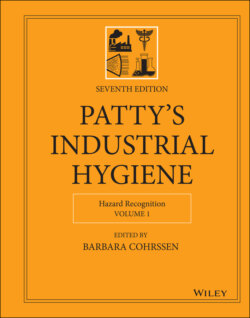Читать книгу Patty's Industrial Hygiene, Hazard Recognition - Группа авторов - Страница 77
4 PD AND SYSTEM SAFETY
ОглавлениеSystem safety can be described as the effort to make things as safe as is practical by systematically using engineering and management tools to identify, analyze, and control hazards (10). Principles or tenets of system safety described by Stephans in his book, System Safety for the twenty‐first century seem to align closely with PtD concepts found in Z590.3 and the ANSI/ASSP 31000:2018 risk management standard and are shown in Table 2 (1).
Table 2 System safety tenets and prevention through design alignment (1).
| S.No. | System safety tenets | PtD concepts |
|---|---|---|
| 1. | Systematically identify, evaluate, and control hazards in order to prevent (or mitigate) accidents | Hazard analysis and risk assessment |
| Risk treatment | ||
| 2. | Apply a precedence of controls to hazards starting with their elimination, designing to preclude hazards, and finally administrative controls. Administrative controls include signs, warnings, procedures, and training. (The lowest precedence are those controls that rely on people.) | Risk treatment |
| The hierarchy of controls | ||
| Layers of protection | ||
| 3. | Perform proactively rather than reacting to events. This starts with a program plan. | Risk management process |
| Prevention through design | ||
| 4. | Design and build safety into a system rather than modifying the system later in the acquisition process when any changes are increasingly more expensive | Prevention through design |
| 5. | Develop and provide safety‐related design guidance and give it to the designers as the program is initiated | Prevention through design |
| Design safety specifications | ||
| 6. | Use appropriate evaluation/analysis techniques from the tabulated variety available | Hazard analysis and risk assessment |
| 7. | Rely on factual information, engineering, and science to form the basis of conclusions and recommendations | Establish context |
| Risk‐based decision making | ||
| 8. | Quantify risk by multiplying the ranking of undesired consequences of an event by the probability of occurrence. There are variations to this “equation” | Risk analysis |
| 9. | Design, when allowed, to minimize or eliminate single‐point failures that have an undesired consequence. Make at least two‐fault tolerant, that is tolerant of multiple faults or system breakdown that would have adverse safety consequence | Prevention through design |
| Layers of protection/defenses | ||
| 10. | Identify, evaluate, and control hazards throughout the system's life and during the various operational phases for normal and abnormal environments | Prevention through design and re‐design |
| Design safety reviews | ||
| Management of change | ||
| System's lifecycle | ||
| 11. | After application of controls to mitigate a hazard(s), management must recognize and accept the residual risk | Acceptable risk level |
| As low as reasonably practicable (ALARP) | ||
| 12. | Recognize the quality assurance interface: (i) Decrease risk by using materials that are properly specified and possess adequate quality assurance and (ii) implement to continually improve the system | Design safety specifications |
| 13. | Tabulate and disseminate lessons learned and incorporate those lessons for future safety enhancement | Risk communication and consultation |
| 14. | Apply system safety to systems to include processes, products, facilities, and services | Prevention through design |
| 15. | Recognize that near‐miss conditions, if not corrected, most likely develop into accidents | Hazard/risk identification |
| Risk assessment | ||
| Risk treatment |
Source: From Lyon et al. (1). © 2019.
A review of Table 2 reveals that there are strong correlations between system safety and PtD concepts. The concepts of risk avoidance and reduction through assessment, treatment, and design into system elements are fundamental to both system safety and PtD.
